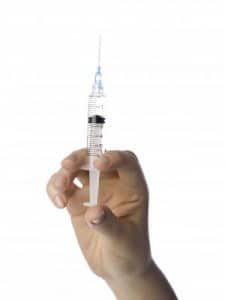
To hopefully ease the pain for children, and concern for parents, Lisa A Jackson, MD, MPH, senior investigator at Group Health Research Institute, and her colleagues recently decided to test if injection site side effect risks, like swelling and redness, would be lower if the injection was given in the thigh (the current recommendation for children under 3 years) rather than the arm.
“These local reactions are the most common side effects of vaccinations. But we have known relatively little about how to prevent them,” Jackson told Medical News Today.
Focusing on “medically attended” local reactions (reactions that resulted in a visit with a doctor, nurse or emergency room attendant), the study tracked the local reactions in 1.4 million vaccinated children. Children between the ages of 12 and 35 months were found to be half as likely to be brought in for medical attention for an injection site reaction when given the vaccine in their thigh. However, no significant risk difference was found for children between the ages of 3 and 6. This was true, not just for the DTaP injection, but also the influenza and hepatitis A vaccination, which the authors also followed over the course of the study.
“Our findings support current recommendations to give intramuscular vaccinations in the thigh for children younger than three,” Jackson said.
This isn’t the first study to find a lower risk of site injection reactions when immunizations are given in the thigh muscle rather than the arm muscle. A previous study, conducted on children between 4 and 6 years of age who had already received five DTaP injections, found that children who received the vaccine in their thigh had fewer reactions than those who’d received the immunization in their thigh.
And for those parents who use ibuprofen (Advil) or acetaminophen (Tylenol) to help with immunization pain or fevers, you may find it beneficial to know that Dr. Jackson previously tested to see if these medications would help with local reactions after vaccination. While they may be effective at helping with the pain or fever, the study did not find any indication that these medications helped with local reactions like swelling and redness.
Related Articles:
- Study: Women Diagnosed with Preeclampsia during Pregnancy Have Higher Risk of Postpartum Hypertension
- Wave of the Future: Pap Smears Being Redesigned to Detect Uterine and Ovarian Cancers
- Researchers Identify All Bacteria Strains in Breast Milk and Colostrum







To learn more about the DTaP vaccine, visit the Vaccine Education Center at The Children’s Hospital of Philadelphia’s website, “A look at each vaccine: DTaP vaccine”: http://www.chop.edu/service/vaccine-education-center/a-look-at-each-vaccine/dtap-diphtheria-tetanus-and-pertussis-vaccine.html. You can also learn about how to prepare for vaccines given to different age groups by visiting http://www.chop.edu/service/parents-possessing-accessing-communicating-knowledge-about-vaccines/age-groups-and-vaccines/.